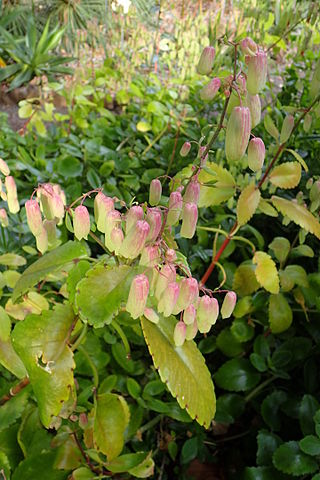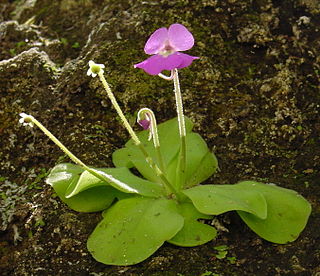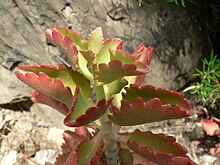
Pachypodium baronii, the Madagascar palm or bontaka, is a flowering plant in the family Apocynaceae. It has the habit of a robust shrub with a spherical or bottle-shaped trunk. It has several cylindrical branches at the top.
Pachypodium bicolor is a species of plant in the family Apocynaceae.

Kalanchoe beharensis is a plant species in the succulent genus Kalanchoe, and the family Crassulaceae. Kalanchoe beharensis is native to Madagascar known by local names mongy, rongy and tavitavy.

Pachypodium brevicaule is a species of plant that belongs to the family Apocynaceae.

Cotyledon is one of some 35 genera of succulent plants in the family Crassulaceae. Mostly from Southern Africa, they also occur throughout the drier parts of Africa as far north as the Arabian Peninsula. Ten of its species are mostly confined to South Africa, where unlike Tylecodon, they occur commonly in both the winter and summer rainfall regions. They may be found on coastal flats and rocky hillsides, or as cremnophytes on cliff faces. Their decussate, evergreen leaves are very variable in shape, even within some species, but the flowers are, apart from colour, very similar.

Lobelia scaevolifolia is a species of the plant family Campanulaceae. It is endemic to the island of Saint Helena in the South Atlantic Ocean. It was at one time placed as the only species, Trimeris scaevolifolia, in the genus Trimeris. Its common name is St. Helena lobelia.

Cotyledon orbiculata, commonly known as pig's ear or round-leafed navel-wort, is a South African succulent plant belonging to the genus Cotyledon.

Kalanchoe delagoensis, formerly known as Bryophyllum delagoense and commonly called mother of millions or chandelier plant, is a succulent plant native to Madagascar. Like other members of Bryophyllum, it is able to propagate vegetatively from plantlets that develop on its leaf margins.

Kalanchoe pinnata, commonly known as cathedral bells, air plant, life plant, miracle leaf, Goethe plant, and love bush, is a succulent plant native to Madagascar. It is a popular houseplant and has become naturalized in tropical and subtropical areas. The species is distinctive for the profusion of miniature plantlets that form on the margins of its leaves, a trait it has in common with some other members of Bryophyllum.

Brunfelsia pauciflora is a species of flowering plant in the family Solanaceae, the nightshades. It is endemic to Brazil, and it is grown in cultivation. A shrubby perennial plant grown in gardens, its common names include today, tomorrow together, yesterday, today and tomorrow, morning-noon-and-night, kiss me quick, and Brazil raintree.

Pinguicula elizabethiae is a perennial rosette-forming insectivorous herb native to the Mexican states of Querétaro and Hidalgo. A species of butterwort, it forms summer rosettes of flat, succulent leaves up to 5 centimeters (4 in) long, which are covered in mucilaginous (sticky) glands that attract, trap, and digest arthropod prey. Nutrients derived from the prey are used to supplement the nutrient-poor substrate that the plant grows in. In the winter the plant forms a non-carnivorous rosette of small, fleshy leaves that conserves energy while food and moisture supplies are low. Single purple flowers appear between July and October on upright stalks up to 75 millimeters long.

Brunfelsia latifolia, commonly known as yesterday-today-tomorrow and kiss me quick, is a species of flowering plant in the nightshade family. Endemic to Brazil, it is an evergreen shrub that becomes semi-deciduous in cooler areas and grows up to 1.8 meters in height.

Pachyphytum is a small genus of succulents in the family Crassulaceae, native to Mexico, at elevations from 600 to 1,500 metres. The name comes from the ancient Greek pachys (=thick) and phyton (=plant) because of the shape of the leaves.

Agalinis paupercula, commonly known as the smallflower false foxglove, is a hemiparasitic annual plant native to the eastern parts of the United States and Canada. Found in open, moist areas, its purple flowers are borne on a 30-to-70-centimeter stem, and bloom in August and September. The species has often been treated as a variety of Agalinis purpurea, the purple false foxglove, and preliminary genetic evidence suggests that the two are, in fact, a single species.
Kalanchoe fadeniorum is a species of Kalanchoe in the family Crassulaceae.

Kalanchoe longiflora, also known as tugela cliff-kalanchoe or long-flower kalanchoe, is a species of the succulent genus Kalanchoe, in the family Crassulaceae. An obscure shrub native to South Africa, it is known for its multi-coloured foliage and yellow flowers, which bloom in autumn to winter.
Larsenianthus arunachalensis is a species of the genus Larsenianthus in the ginger family (Zingiberaceae).. It was first described in 2010 and is native to northeastern India, and Myanmar.

Otholobium saxosum is a small shrublet of up to 20 cm (7.9 in) high that has been assigned to the Pea family, with branches upright or horizontal at the base with rising tips. It has sessile, clover-like leaves and white, pea-like flowers that grow in triplets in the axils of the upper leaves of new, short side shoots. The species is only known from Garcia's Pass in Western Cape province of South Africa. Flowering occurs in October and November.
Plectranthus purpuratus or cliff spurflower is a species of flowering plant in the family Lamiaceae, native to South Africa's Kwazulu-Natal and Mpumalanga provinces, as well as eSwatini. The name is frequently misapplied to Plectranthus ciliatus, presumably because both have purple-backed leaves.

Dudleya cymosasubsp. cymosa is a species of succulent perennial plant in the family Crassulaceae native to California. It is the autonymous subspecies for Dudleya cymosa, and is known by the common name canyon liveforever. It is native to the California Coast Ranges, the Sierra Nevada and the Santa Monica Mountains. It is characterized by bright-yellow, orange or red flowers and broad, wide leaves. This plant is commonly found growing on rocky outcrops, talus slopes, and in shaded canyons.

















